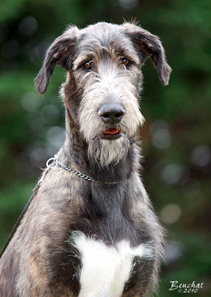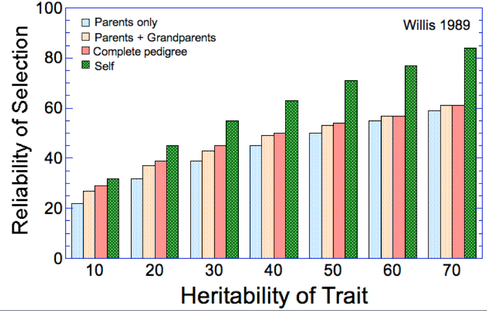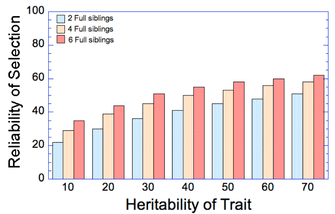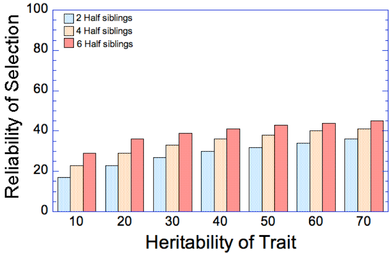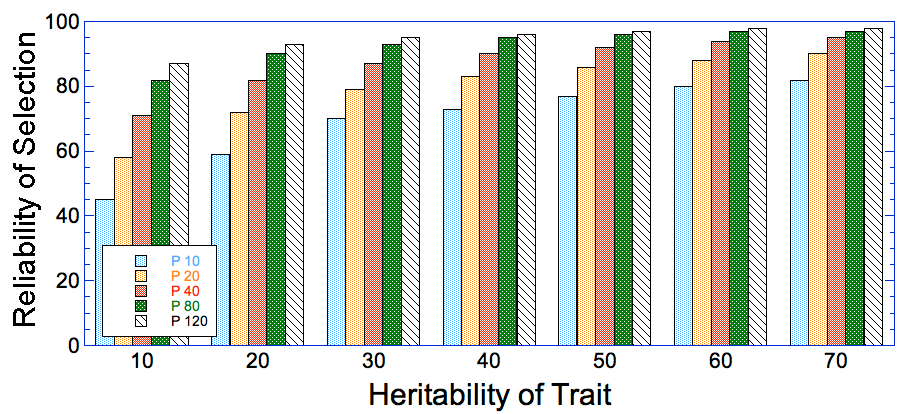| By Carol Beuchat PhD Building a dog is complicated. For some traits (and many genetic disorders) only a single gene is involved. But for most, the phenotype of the animal depends on a genotype that involves many genes. Many of these so-called polygenic traits can vary along continuous scale of expression. Some good examples would be height, running speed, and intelligence. Polygenic traits can be especially difficult to select for (or against) because their expression is often affected by both genes and environment. For example, puppies raised with restricted food might not grow as large as their siblings, and dogs that are less fit might not be able to run as fast as those with performance training. |
or
P = G + E
Heritability is the fraction of the variability in a trait among animals that can be accounted for by genetics; that is, we're looking at the G in the equation above. Let's say you raise an entire litter of puppies under conditions that are identical in every way. If the "environment" term in our equation is zero (i.e., there was no effect of environment), then the heritability of that trait in those puppies is 100%; all of the variation among puppies can be accounted for by differences in genetics. On the other hand, you might measure the same trait in 300 puppies raised in different households. The environment in this case will make a difference and will be different for each litter (and maybe different for each puppy), so genetics will account for less of the variation you see from pup to pup. Heritability is not about how a trait is inherited, but about how much of the variation in a trait from dog to dog an be accounted for by genetics.
Because every group of dogs could experience different environmental factors, an estimate of heritability is specific for a particular group of animals measured at a particular time. If a trait has been measured on many groups of animals under different circumstances, it's possible to determine an average or a range of heritability values that can be used to characterize that trait in general. So for example, estimates of the heritability of subaortic stenosis in the Newfoundland range from 0.17 to 0.45. Heritabilty of lymphoma in Golden Retrievers is 0.44, and of osteosarcoma in Deerhounds is 0.7. Behavioral traits are also heritable: heritability of various hunting traits in Finnish Hounds range from 0.12 to 0.15. (See the table HERE for heritability estimates of various traits.)
It's important to understand heritability because traits with low heritability are more difficult to improve by selection. The phenotype of the trait less reliably reflects the genotype of the dog (so it's harder to select the dogs with the best genes), plus the genes account for less of the improvement you would gain from selection. It is easier to improve traits with high heritability, and you could waste a lot of time and effort trying to improve through selection a trait that is strongly influenced by non-genetic factors.
If you have a rough idea of the heritability of a trait and it's high enough to respond well to selection, then what you wish you knew were the actual genes in a particular dog. A trait might have good heritability, but you won't get very far if the dog you want to breed doesn't have the genes you're trying to select for.
Of course, your best sources of information about the genes in a particular dog are that dog's relatives - the parents it inherited the genes from, the siblings that would also carry some of the same genes, and the progeny that the genes would be passed to. This is where long-time breeders have a definite advantage; knowing the history of a particular line, knowing the parents, grandparents, aunts and uncles, and knowing what a dog produced are all clues to the genetics packaged inside a particular dog. If you don't have this wealth of experience, or you don't know much about a particular line, what information would be most useful for you to collect?
These are graphs that display the relationship between how reliable a particular group of relatives would be in selecting for a particular trait and how this varies with the heritability of the trait. [In these graphs, the environmental effects are not a factor. Reliability is the relationship (as a percentage) between the genetic merit of the dog being evaluated and the phenotype being selected for.]
The first graph below shows that the dog itself provides the most reliable information compared to parents, parents plus grandparents, and the complete pedigree. This graph also shows that the higher the heritability of the trait you are selecting for, the more reliable the dog becomes as a predictor of what will be produced in a particular mating. For traits of low to modest heritability like aortic stenosis in Newfoundlands (0.17-0.45), the phenotype of the dog will predict about 45-65% of the dog's actual genetic merit for that trait. Knowing that a Deerhound suffers from osteosarcoma (heritability of 0.7) would allow you to predict the dog's genotype for that trait with a reliability of about 85%, whereas having that information about parents or grandparents is much less reliable (about 60%). So the information about the dog itself is most informative, and the higher the heritability the more reliable it is. (These data about heritability are from the table in "A better way to pick 'em: using EBVs to reduce genetic disorders in dogs".)
What about information about siblings and half-siblings? These two graphs show how reliability varies if you have information about 2, 4, or 6 full siblings or half-sibs. As you might expect, the more littermates and half-sibs you have information about, the more reliable your assessment of a dog's genotype. Also, full siblings are more informative than half-sibs. Two full siblings provide about as much information as parents for a trait with a specific heritability; for instance 2 siblings and parents have a reliability of about 20% for a trait with a heritability of 10. For traits with higher heritability, the parents are a bit more informative. So information about siblings is very useful, and that from half-sibs is modestly so.
The most reliable information, however, comes from progeny, each of which carries half the genes of that parent. Again as you would expect, the more offspring you have information about, the more reliably you can estimate the actual genetic merit of a dog for a trait, and the gain from additional offspring is most pronounced for traits with low heritability. This graph depicts reliability for 10, 20, 40, 80, and 120 puppies (the legend is in the lower left corner), and for traits with high heritability puppies are the most reliable reflection of the genetic merit of a dog. So for traits with low heritability, the more information you can gather about the trait in offspring the better; reliability of selection improves by about 50% if you have information for 40 puppies instead of just 10, and reliability almost doubles with 80 puppies.
Data from -
- Willis MB. 1989. Genetics of the dog. (table 92)
You can learn more about the genetics of dogs in ICB's Online Courses.
*** Population Genetics for Dog Breeders ***
Next class starts 30 March
Visit our Facebook Groups
ICB Institute of Canine Biology
...the latest canine news and research
ICB Breeding for the Future
...the science of animal breeding
